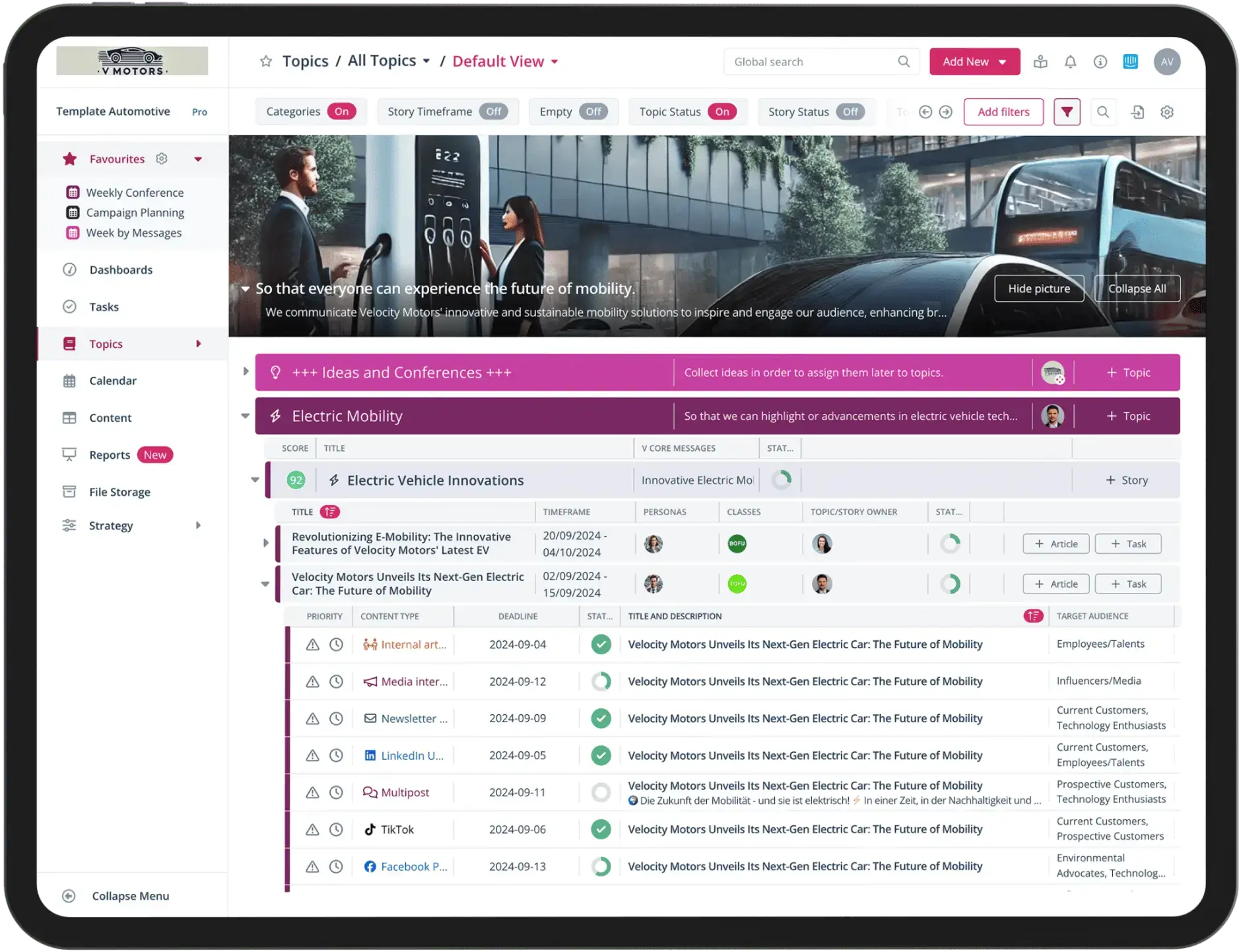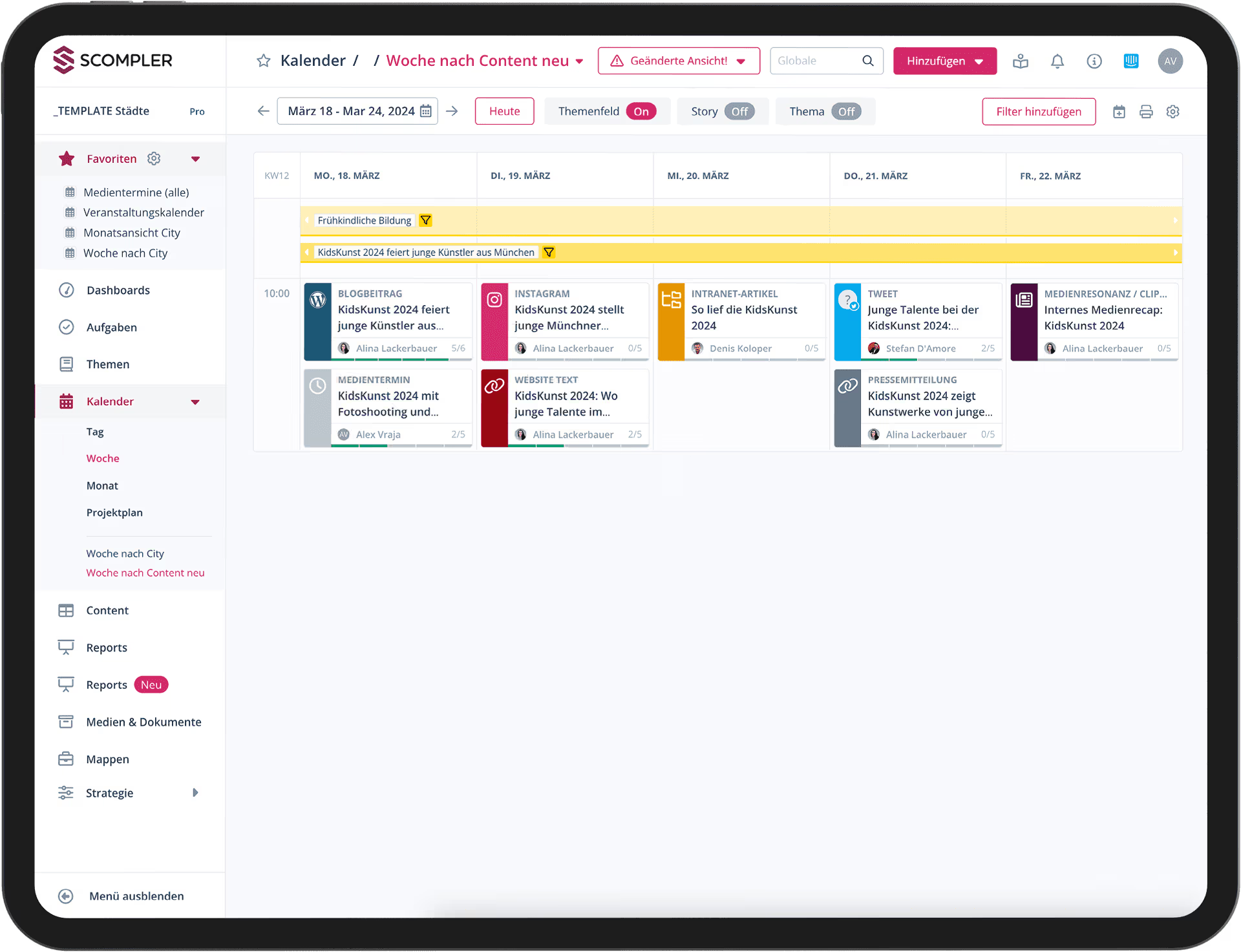Kommunikationsstratgie entwickeln – effektiv und erfolgreich in 2025
Diese Strategie ist ein wesentlicher Bestandteil der Unternehmensführung und trägt maßgeblich zum Erfolg bei. Durch die Entwicklung und Integration einer effektiven Kommunikationsstrategie wird die interne und externe Kommunikation optimiert, was zu einer stärkeren Markenpräsenz und besseren Geschäftsergebnissen führt.

Was ist eine Kommunikationsstrategie?
Eine Kommunikationsstrategie ist ein detaillierter Plan, der die Kommunikationsziele eines Unternehmens festlegt und beschreibt, wie diese erreicht werden sollen. Sie umfasst:
Zielgruppen: Eine klare Definition der Zielgruppen, die angesprochen werden sollen.
Kernbotschaften: Die zentralen Botschaften, die vermittelt werden sollen.
Kommunikationskanäle: Die Kanäle, über die die Kommunikation erfolgen soll (z. B. Social Media, E-Mail, Pressemitteilungen).
Eine gut durchdachte Kommunikationsstrategie hilft dabei:
Konsistenz und Klarheit in allen kommunikativen Maßnahmen zu gewährleisten.
Sicherzustellen, dass die Botschaften das gewünschte Publikum effektiv erreichen.
Das Ansehen und die Glaubwürdigkeit des Unternehmens zu stärken.
Interne und externe Beziehungen zu pflegen.
Letztlich den Geschäftserfolg zu fördern.
Diese Strategie zur Kommunikation ist ein wesentlicher Bestandteil der Unternehmensführung und trägt maßgeblich zum Erfolg bei. Durch die Entwicklung und Integration einer effektiven Kommunikationsstrategie wird die interne und externe Kommunikation optimiert, was zu einer stärkeren Markenpräsenz und besseren Geschäftsergebnissen führt.

Bedeutung einer klaren Kommunikationsstrategie für Unternehmen und Organisationen
Eine Kommunikationsstrategie mit allen Maßnahmen bildet die Basis für jede Interaktion eines Unternehmens. Sie definiert, wie Informationen vermittelt werden, um bestimmte Ziele zu erreichen.
Markenimage und Vertrauen
Eine effektive Kommunikation ist der Schlüssel, um Vertrauen aufzubauen, Kunden zu gewinnen und Unternehmen erfolgreich zu machen.
Darüber hinaus hilft eine klare Kommunikationsstrategie, den Ruf eines Unternehmens zu schützen und Krisensituationen effizient zu managen. Eine klug durchdachtes Konzept ermöglicht es, konsistent Inhalte über verschiedene Kanäle hinweg zu verbreiten und so ein einheitliches Markenimage zu schaffen.
Beispiele und Ziele
Die Kommunikationsziele von Unternehmen und Organisationen können vielfältig sein und hängen stark von den jeweiligen Geschäftsstrategien und -zielen ab. Kommunikationsziele sind:
Markenbekanntheit steigern
Unternehmensreputation aufbauen und pflegen
Markteinführungen und Produktneuerungen
Erhöhung von Kundenbindung und -zufriedenheit
Interne Kommunikation und Mitarbeiterengagement
Krisenkommunikation
Nachhaltigkeit und soziale Verantwortung
Diese Ziele können je nach Unternehmensgröße und Branche variieren, sind jedoch allgemein wichtige Aspekte für eine erfolgreiche Unternehmenskommunikation.
KPIs und Metriken
Um den Erfolg einer Kommunikationsstrategie zu messen, sind klar definierte KPIs (Key Performance Indicators) und Metriken entscheidend. Diese können je nach Konzept und Zielsetzung variieren. Beispiele für relevante KPIs sind Reichweite, Engagement-Rate, Conversion-Rate und Medienberichterstattung. Durch regelmäßiges Monitoring dieser Metriken können Redaktionsteams ihre Strategie anpassen und optimieren.

Kommunikationsstrategie entwickeln in 6 Schritten
Die Entwicklung einer Kommunikationsstrategie erfordert sorgfältige Planung und eine systematische Herangehensweise. Hier sind eine grundlegende Anleitung zur Entwicklung eines Kommunikationskonzepts:
Schritt 1: Zielgruppenanalyse und Zielsetzungen
Der erste Schritt zur Entwicklung eines Kommunikationskonzeptes ist die Zielgruppenanalyse. Es ist wichtig zu verstehen, wer die Buyer Persona ist, welche Bedürfnisse und Interessen sie hat und über welche Kanäle sie am besten erreicht werden kann. Darauf aufbauend können klare Zielsetzungen formuliert werden, die als Leitfaden für die gesamte Kommunikation dienen.
Zur Erreichung der Ziele ist es entscheidend, dass sie ihre Buyer Persona genau kennen, um deren Bedürfnisse, Wünsche und Herausforderungen zu verstehen. Nur so können Sie Botschaften entwickeln, die wirklich relevant und ansprechend sind. Führen Sie Umfragen durch, analysieren Sie Daten und setzen Sie sich intensiv mit dem Verhalten Ihrer Zielgruppe auseinander, um fundierte Einblicke zu gewinnen.
Schritt 2: Die richtigen Kommunikationskanäle wählen
Es gibt viele Kommunikationskanäle, um Ihre Inhalte zu verbreiten – von sozialen Medien über E-Mail-Marketing bis zu Pressemitteilungen. Jede Plattform hat ihre Vor- und Nachteile. Entscheidend ist, die richtigen Kanäle auszuwählen, um Ihre Zielgruppe effektiv zu erreichen. Eine gründliche Analyse Ihrer Buyer Persona hilft Ihnen, die besten Kommunikationsmaßnahmen und -kanäle für Ihre Strategie auszuwählen.
Gerade im Bereich Social Media sollten Sie aktuelle Trends und Entwicklungen beachten. Die digitale Landschaft verändert sich ständig, und neue Plattformen und Tools kommen regelmäßig hinzu. Je nach Branche und Unternehmensgröße kann es sinnvoll sein, regelmäßig zu prüfen, ob Ihre aktuellen Maßnahmen noch effektiv sind oder ob es neue Möglichkeiten gibt, Ihre Zielgruppe zu erreichen.
Nicht zu vernachlässigen ist auch die interne Kommunikation. Maßnahmen wie Intranet, Mitarbeiter-Newsletter oder interne Social-Media-Gruppen können dazu beitragen, ein starkes Zusammengehörigkeitsgefühl und eine offene Unternehmenskultur zu schaffen.
Schritt 3: Botschaften festlegen
Themen und Kernaussagen sind das Herzstück jeder Kommunikationsstrategie. Sie müssen klar, prägnant und relevant für Ihre Zielgruppe sein. Eine gute Botschaft sollte die Kernbotschaft Ihres Unternehmens widerspiegeln und gleichzeitig einen Mehrwert für den Empfänger bieten.
Überzeugende Botschaften verfassen
Um Zielgruppen zu erreichen, sind klare und überzeugende Aussagen der Kern jeder erfolgreichen Unternehmenskommunikation. Inhalte sollten greifbar, relevant und authentisch sein. Sie sollten einen Mehrwert bieten und Ihre Zielgruppe dazu inspirieren, mit Ihrem Unternehmen in Kontakt zu treten und Ihre Produkte oder Dienstleistungen zu nutzen. Kommunikationswissenschaftler beschreiben diese Art von Botschaften als „Storytelling“, da sie eine emotionale Verbindung zu den Empfängern herstellen.
Nutzen Sie Storytelling, um Ihre Marke lebendig und nahbar zu gestalten. Verwenden Sie eine emotionale und überzeugende Sprache, um Ihre Zielgruppen zu berühren und zu begeistern.
Weitere Erfolgsfaktoren sind neben der Planung von Textinhalten auch visuelle Elemente wie Bilder, Videos oder Infografiken in Ihren Content-Kalender integrieren. Visuelle Inhalte sind oft ansprechender für Ihre Zielgruppe und können die Reichweite und das Engagement Ihrer Beiträge steigern. Stellen Sie zudem sicher, dass Ihre Inhalte auf allen Kanälen einheitlich kommuniziert werden.
Themenplanung mit Scompler
Mit Scompler stellen wir Redaktionsteams ein Tool zur Content-, Social Media- und Projektplanung zur Verfügung. Ein gut strukturierter Themenplan verschafft Ihnen einen Überblick und sorgt in Verbindung mit einem Content-Kalender, die Performance Ihrer Inhalte im Laufe der Zeit zu verfolgen. Indem Sie Daten zu Veröffentlichungszeiten, Themen und Interaktionen sammeln, können Sie Muster erkennen und Ihre zukünftigen Inhalte optimieren.
Schritt 4: Konsistente Markenstimme entwickeln
Wenn Sie eine Kommunikationsstrategie entwickeln, sollte diese die Identität Ihrer Marke widerspiegeln. Eine konsistente Markenstimme hebt Sie auch als Arbeitgeber von den Mitbewerbern ab und stärkt die Positionierung ihres Unternehmens. Definieren Sie Ihre Markenwerte, -persönlichkeit und -botschaften und stellen Sie sicher, dass diese in all Ihren Kommunikationsmaßnahmen klar erkennbar sind.
Die Definition einer konsistenten Markenstimme erfordert eine gründliche Analyse Ihrer Zielgruppe und Wettbewerber. Indem Sie die Bedürfnisse, Werte und Präferenzen Ihrer Zielgruppe verstehen, stellen Sie sicher, dass Ihre Markenbotschaften relevant und ansprechend sind. Gleichzeitig ist es wichtig, die Konzepte Ihrer Wettbewerber zu analysieren, um Ihr Kommunikationskonzept differenziert und einzigartig zu positionieren.
Durch eine strukturierte und systematische Herangehensweise wird Ihre Marke als vertrauenswürdige und umfassende Informationsquelle positioniert.
Schritt 5: Feedback-Mechanismen implementieren
Feedback ist ein essenzielles Werkzeug zur Optimierung und Anpassung Ihrer Kommunikation. Implementieren Sie Feedback-Mechanismen, um die Reaktionen Ihrer Zielgruppe zu messen und wertvolle Einblicke in deren Bedürfnisse und Präferenzen zu gewinnen.
Nutzen Sie diese Daten, um den Erfolg Ihrer Kommunikationsbemühungen zu bewerten und Ihre Strategie zu verfeinern und fortlaufend zu verbessern.
Die Implementierung von Feedback-Mechanismen erfordert sorgfältige Planung und Durchführung. Feedback-Schleifen sollten eingerichtet werden, um sicherzustellen, dass die gewonnenen Informationen tatsächlich in die Optimierung der Kommunikationsstrategie einfließen.
Schritt 6: Evaluation und Anpassung
Eine erfolgreiche Kommunikationsstrategie ist ein kontinuierlicher Prozess. Es ist entscheidend, regelmäßig Zeit darauf zu verwenden, Ihre Strategie zu bewerten und Ziele anzupassen.
Bei der Evaluierung Ihrer Kommunikationsstrategie ist es unerlässlich, sowohl quantitative als auch qualitative Aspekte zu berücksichtigen. Analysieren Sie das Feedback Ihrer Zielgruppe, um tiefere Einblicke in deren Bedürfnisse und Präferenzen zu erhalten. Diese Informationen ermöglichen es Ihnen, Ihre Aussagen und Inhalte gezielter anzupassen und eine stärkere Bindung zu Ihren Kunden aufzubauen.
Zusätzlich zur regelmäßigen Überprüfung Ihrer Kommunikationsstrategie sollten Sie zudem auch Branchentrends im Auge behalten. Neue Technologien und Verhaltensweisen können sich schnell ändern und die Art und Weise beeinflussen, wie Sie mit Ihrer Zielgruppe interagieren. Durch proaktives Reagieren auf diese Veränderungen und die entsprechende Anpassung Ihrer Strategie stellen Sie sicher, dass Sie weiterhin relevant und wirkungsvoll bleiben.
Paul Watzlawick, ein bekannter Kommunikationswissenschaftler, sagte:
„Man kann nicht nicht kommunizieren.“
Paul Watzlawick
Dies gilt besonders für Unternehmen. Eine effektive und strategische Kommunikation ist entscheidend für die Wahrnehmung Ihrer Marke. Mirko Lange (Gründer von Scompler) geht hier noch einen Schritt weiter. Sein Motto:
„Es reicht nicht, keine Content Strategie zu haben. Man muss auch unfähig sein, sie im Tagesgeschäft umzusetzen.“
Mirko Lange

Beispiele für erfolgreiche Kommunikationsstrategien
Ein Blick auf die Unternehmenskommunikation anderer Unternehmen kann wertvolle Einblicke und Inspirationen bieten. Beispielsweise hat Coca-Cola mit seiner „Share a Coke“-Kampagne gezeigt, wie personalisierte Kommunikation die Kundenzufriedenheit steigern kann. Ein weiteres Beispiel ist die Krisenkommunikation von Toyota während der Rückrufaktionen, bei der Transparenz und schnelle Reaktion entscheidend für die Wiederherstellung des Kundenvertrauens waren.
Beispiel: Newsroom der Welthungerhilfe
Der Newsroom der Welthungerhilfe stellt einen wichtigen Meilenstein in der weltweiten Unternehmenskommunikation dar, da er eine effiziente und koordinierte Zusammenarbeit mit Redakteuren auf der ganzen Welt ermöglicht.
Durch die zentrale Verwaltung von Informationen und die einheitliche Abstimmung der Kommunikationsaktivitäten wird sichergestellt, dass alle Nachrichten und Publikationen konsistent und zeitnah verbreitet werden. Dies verbessert nicht nur die Transparenz und Glaubwürdigkeit der Welthungerhilfe, sondern stärkt auch ihre Position als verlässliche und kompetente Informationsquelle im Kampf gegen den globalen Hunger. Hier finden Sie weitere Informationen zum Newsroom.
Beispiel: Fridays for Future
Fridays for Future verwendet die Scompler App zur Planung und Umsetzung der Kommunikationsstrategie. Scompler unterstützt die Organisation dabei, ihre Themen zielgerichtet und konsistent zu verbreiten. Durch eine strukturierte Planung kann die Organisation Reaktionen auf ihre Beiträge in Echtzeit zu verfolgen und auf aktuelle Ereignisse schnell reagieren. Dies stellt sicher, dass ihre Kommunikation stets relevant und aktuell ist.
FAQs
Eine SWOT Analyse ist ein strategisches Planungstool, das die Stärken (Strengths), Schwächen (Weaknesses), Chancen (Opportunities) und Risiken (Threats) eines Unternehmens identifiziert.
Für die Unternehmenskommunikation ist die Analyse wichtig, weil sie dabei hilft, Kommunikationsstrategien zu entwickeln, die die Stärken des Unternehmens betonen, die Schwächen minimieren, Chancen nutzen und potenzielle Risiken adressieren.
Die Entwicklung einer gezielten Kommunikationsstrategie erfolgt in mehreren Schritten und beginnt mit einer sorgfältigen Zielgruppenanalyse. Unternehmen sollten demografische Daten, Verhaltensweisen und Präferenzen ihrer Zielgruppen untersuchen und daraus maßgeschneiderte Inhalte, Kanäle und Maßnahmen ableiten.
Die Wirksamkeit einer Kommunikationsstrategie kann durch das Monitoring von KPIs und Metriken gemessen werden. Regelmäßige Auswertungen und Anpassungen basierend auf den erzielten Ergebnissen sind entscheidend für den langfristigen Erfolg.
Eine effektive Kommunikationsstrategie erfordert eine gründliche Zielgruppenanalyse, die Festlegung klarer Ziele, die Auswahl geeigneter Kanäle und Medien, die Erstellung konsistenter Botschaften und das regelmäßige Monitoring und Anpassen der Strategie.

Kommunikationskonzept: Die 3 wichtigsten Erfolgsfaktoren
Die Entwicklung einer Kommunikationsstrategie erfordert sorgfältige Planung und eine systematische Herangehensweise. Hier sind eine grundlegende Anleitung zur Entwicklung eines Kommunikationskonzepts:
Klarheit und Konsistenz der Botschaften: Es ist entscheidend, dass die Kommunikation klar, verständlich und konsistent ist. Alle Botschaften sollten die Werte und die Mission des Unternehmens widerspiegeln, um Missverständnisse zu vermeiden und das Vertrauen der Zielgruppe zu stärken.
Integration und Koordination: Eine erfolgreiche Kommunikationsstrategie erfordert Integration und Koordination zwischen Abteilungen und Kanälen. Alle Mitarbeiter und Teams sollten gut informiert und abgestimmt sein, um eine einheitliche Kommunikation sicherzustellen.
Flexibilität und Anpassungsfähigkeit: In einer sich ständig verändernden Kommunikationslandschaft ist es wichtig, flexibel zu bleiben und die Strategie schnell anzupassen. Das bedeutet, kontinuierlich Feedback zu berücksichtigen und die Kommunikationsaktivitäten zu optimieren, um relevant zu bleiben.
Ein Corporate Newsroom ist eine zentrale Informations- und Kommunikationsplattform innerhalb eines Unternehmens, die es ermöglicht, sämtliche Inhalte und Nachrichten effektiv zu sammeln, zu organisieren und zu verbreiten. Im Newsroom arbeiten Redakteure und Kommunikationsexperten eng zusammen, um eine konsistente und zielgerichtete Kommunikation sicherzustellen.
Unternehmen sollten stets ein Ohr am Markt haben, um auf Veränderungen flexibel reagieren zu können. Regelmäßige Marktanalysen und Feedbackschleifen helfen, die Strategie kontinuierlich zu optimieren.
Je nach Zielgruppe und Zielsetzung können verschiedene Kanäle und Maßnahmen geeignet sein. Beispiele sind soziale Medien, E-Mail-Marketing, Pressemitteilungen, Blogs und Veranstaltungen.
Zu den Herausforderungen gehören vor allem mangelnde Konsistenz, negative Medienberichterstattung und unvorhergesehene Krisensituationen. Ein gut vorbereiteter Krisenkommunikationsplan kann dabei helfen, Risiken zu minimieren.
Eine konsistente Kommunikation erfordert klare Richtlinien und regelmäßige Schulungen der Mitarbeiter. Ein einheitlicher Kommunikationsstil und abgestimmte Botschaften sind entscheidend.
Konsistente und authentische Markenkommunikation ist entscheidend für den Aufbau von Vertrauen und Glaubwürdigkeit. Sie stärkt die Markenidentität und fördert langfristige Kundenbeziehungen.
Die Zielgruppenanalyse bildet die Grundlage für die gesamte Strategie. Sie hilft, die Bedürfnisse und Präferenzen der Kunden zu verstehen und maßgeschneiderte Kommunikationsaktivitäten zu entwickeln.
Relevante Artikel
Learn how to grow your business with our expert advice.

Neue Integration von Scompler und Staffbase verstärkt die Integration für einheitliche Botschaften
Scompler und Staffbase präsentieren eine erweiterte Integration, die interne und externe Kommunikation enger miteinander verbindet. Durch die tiefere Verknüpfung von strategischer Planung und mitarbeiterorientierten Kommunikationskanälen können Organisationen Inhalte nahtlos planen, erstellen, veröffentlichen und analysieren – alles aus einem zentralen Prozess heraus. Die neuen Funktionen stärken die Konsistenz von Botschaften, optimieren Workflows und machen interne Kommunikation messbarer und strategischer.








